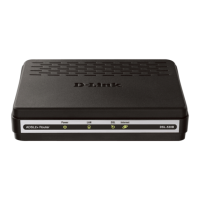Section 2 – Installation
Information you will need about your LAN or computer:
Ethernet NIC
If your computer has an Ethernet NIC, you can connect the DSL-520B to the Ethernet port using an Ethernet cable. You can also use the Ethernet
ports on the DSL-520B to connect to other computers or Ethernet devices.
DHCP Client status
Your DSL-520B ADSL Router is configured, by default, to be a DHCP server. This means that it can assign an IP address, subnet mask and a
default gateway address to computers on your LAN. The default range of IP addresses the DSL-520B will assign are from 192.168.1.2 to
192.168.1.254. Your computer (or computers) needs to be configured to obtain an IP address automatically (that is, they need to be configured as
DHCP clients.)
It is recommended that you collect and record this information here, or in some other secure place, in case you have to re-configure your ADSL
connection in the future.
Once you have the above information, you are ready to setup and configure your DSL-520B ADSL Router.
D-Link DSL-520B User Manual
12

